| TIPS FOR CHOOSING THE RIGHT PICTURE FRAME:
|
 |
| How to select the best picture frame for your canvas print or fine art photograph? Some people spend days or weeks choosing the perfect canvas print or painting. They research the artist, the period and the history of the canvas itself. They budget and sample and relocate family photographs to make room. Then, once the canvas piece is purchased, they grab the first correctly sized picture frame off the rack and plop it onto their precious new canvas acquisition.
Whether you've purchased an original acrylic or oil painting, a gallery wrapped Giclée canvas print, a paper print of an artwork, or a fine art paper photograph, it is important to put some serious thought into your frame selection; it is as much as a part of the final art display as the piece itself.
|
Era of Artwork
In museums, canvas paintings are often bordered with the style of frame it would have been shown in when it was created - generally an ornate gold, to border the watercolor, oil or acrylic painting. If you have a Giclée canvas print - or, lucky you, an original - of an Impressionism or Renaissance painting, it's a pretty safe bet that a similar picture frame to that worn by the original painting in the Louvre or the National Gallery is a suitable style choice.
If your artwork is more modern - a Giclée canvas print of an abstract painting, sketch, or photograph, for instance - then the choice is less clear. Often, a solid colour picture frame - black or white, or a simple wood grain finish with a flat or geometric face - will work very well. In certain cases, a more decorative frame might work. Look for ornamented or detailed picture frames that highlight the best qualities of your artwork, without removing the attention from the piece and placing it on the frame instead.
|

A gold leaf, scoop profile distressed frame brings out the skin tones in Mona Lisa's face and neck.
|
Matching the Painting or Print to The Frame
What is the colour scheme of your photograph or canvas? Is it full of bold reds and oranges, fiery hues that dominate the print's design and draw the eye instantly toward the piece? A canvas or paper print featuring these bright, deep colours pairs nicely with a plain black picture frame. If the piece itself is fairly simple, consider a picture frame with an inner lip design. This will allow you to decorate the border a little bit, without completely overpowering the simplicity of the painting or Giclée canvas print itself.
Or, is your artwork a classic watercolour of blues and greens that swirl across the canvas - the kind of art piece that suits the wall so unobtrusively it sometimes goes unnoticed? These canvas or paper prints and paintings often work well with a white mat separating them from a gold or glossy wood frame.
Just because a certain picture frame doesn't clash with your canvas or fine art print doesn't mean it's the perfect fit. Consider the "vibe" you want your oil or acrylic painting to create. If it is a Impressionist street scene at night for instance, a black picture frame, while not mismatched, could evoke sad, dreary sentiments by drawing out the darker blues, grays and greens within the art. But highlight the golds and yellows of the streetlamps with a shiny gold, carved picture frame, and the result is an inviting evening stroll.
|
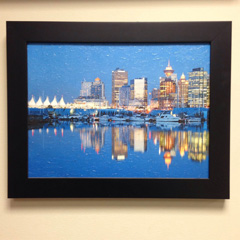
A plain and simple, black frame highlights the blues of this skyline canvas print
|
Purpose of the Picture Frame
Once you have determined the colour palate, and which frames could work with your painting, fine art photo or canvas print, it is important to figure out what you want your new picture frame to do. Do you want it to simply provide a border for that watercolor, so it can continue to grace your wall with subtle beauty? Or do you want to turn that quiet Giclée canvas print into an arresting centrepiece that will never again go unnoticed?
If the latter is your preference, keep in mind that picking the first ornate, intricately designed picture frame you find is not the answer. While a bold, Victorian-era frame might be just the thing to pull the painting from drab to dramatic, try to pick a frame that complements the canvas but doesn't take over. Too ornate, and the painting will again become a barely-there entity, lost within an overpowering border.
If you want the frame for your canvas painting or print to remain a simple border, you might consider a floater frame.
Your stretched canvas fits neatly into your floating canvas frame, attaching to the inside lip. This allows your canvas to "float", with a few millimeters of space between the outer edge of the canvas print and the inner edge of the floater picture frame. Our frame selections range from simple, to rustic, to modern, and accomodate all sizes of canvas prints.
|

|
Choosing a Mat
Once you have determined the type of frame you want for your painting or Giclée print, your work is still not finished. Now you must decide whether your artwork requires any additional decor around its border. If you are framing a print or original artwork on paper, you will most likely be placing glass over the piece. You therefore have the option of placing a mat - a stiff, high quality board with a cut out in the center for your picture - between the glass and the artwork.
A mat creates space between the Giclée print and the frame. This is ideal for many reasons; for instance: if you have an ornate frame that slightly overpowers the artwork, the mat will provide a subtle barrier that gives your print a chance to breathe on its own, and gives it its own space, separate from the picture frame. Regardless of the frame, the mat will always provide a viewing area around your picture that is free of other distractions. When the eye reaches the edge of the print, for instance, it will be brought back into the print because there is nothing at the edge to pull the eye away.
Mats are most often white or some pale shade of gray, or cream, as this is the best distraction-free border. However, we offer mats in a large variety of colors, from bold-hued blue and red to suede-textured forest green. If you want your Giclée fine art paper print to really pop, consider selecting a mat in a shade that complements the best color in the image.
The color selection is not the only consideration in the image mat category. You need to decide how wide you would like your mat to be. Too narrow, and your Giclée print or photograph will appear too large, and therefore stuffed, into the frame. Too wide, and your image is no longer the focal point of your display. 2" is most the common mat width for images up to about 24x30". Naturally, large framed prints and photographs will require a wider mat (based on percentage).
If you aren't exhausted by mat options already, you can consider double- or even triple-matting your print. This adds more depth, and can bring out multiple shades or colors in your image. Generally, the inner mat (sometimes called a slip mat) in a double mat image will protrude approximately 1/4" farther than the outer mat. This means the total mat depth on each side for a medium-size artwork will be 2 1/4".
There is no definitive right mat for any one photograph or Giclée print. Use your best judgement, or ask someone with a more practiced eye. If you decide you do not want a mat at all, that is a stylistic choice as well.
A final reminder: in general, wider picture frames (2.25 inches or more) are best for large canvas prints and painting, and fine art papers, while narrow frames (1.5 inches or less) are better suited to small pieces. A mid-size artwork can handle a mid-sized frame (around 2 inches).
|



|
| Consider the artwork, the display, and the frame. But at the end of the day, pick something you like, despite what this article, elsewhere on the internet, and high society art friends might tell you. After all, it needs to match your existing decor, and you're the one who has to love it!
|
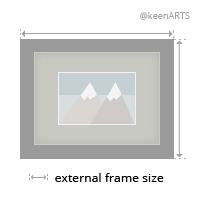
Front Side |
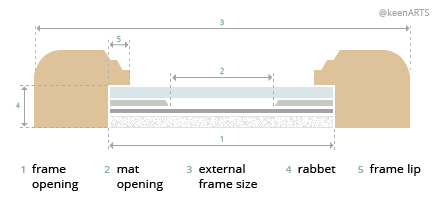
Picture framing terms |
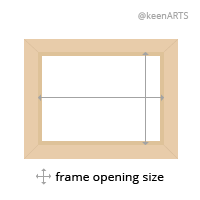
Back Side |
| MatBoard Guide: |
 |
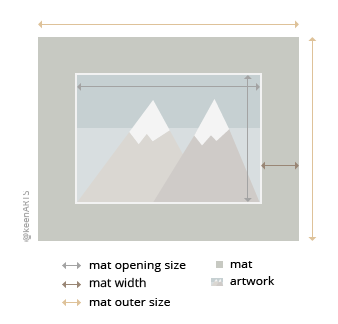 Single Matboard Sample |
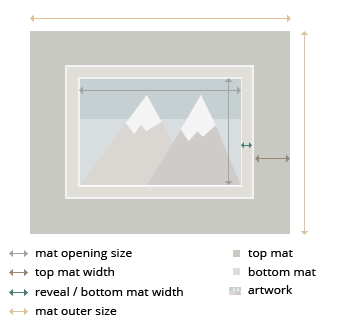 Double Matboard Sample |
|
Terms:
Top Mat: Top layer of a double mat; It has a larger window, which allows a small border of the bottom mat, called the reveal, to be shown.
Bottom Mat: Optional second layer of matboard used in double matting; The window opening of the bottom mat surrounds the artwork.
Reveal: Width of the bottom mat, normally 1/4", 3/8" & 1/2"
Mat Outer Size: Also known as frame opening size, matches the plexi glass or backing size of the picture frame
Artwork Size: The exact size of the artwork!
Mat Opening Size: Size of the matboard window cut out
|
|
|
Our informative articles on MatBoards:
Choosing the Best Mat Size The article offers helpful tips on selecting the appropriate mat size for your artwork.
Measuring for Mats All about Mat Outer Size, Artwork Size and Mat Opening Size
Choosing Mat Color How to select the best colors of mat fo ryour artwork
All About Mats The article discusses the different materials and attributes of picture framing mats and more!
|
|
© 2002-2026 - KeenART Media Ltd.
|
|
| |
|

